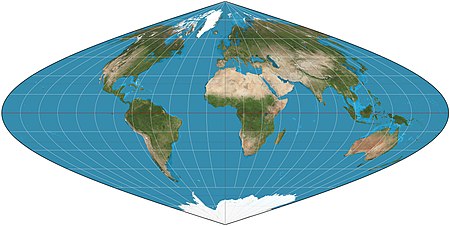Tests of general relativity: Difference between revisions
en>Anti-McK |
en>Monkbot |
||
| Line 1: | Line 1: | ||
[[File:Carte cosmographique ou Universelle description du monde, Jean Cossin, Dieppe, 1570.png|thumb|Jean Cossin, Carte cosmographique ou Universelle description du monde, Dieppe, 1570]] | |||
[[File:Sinusoidal projection SW.jpg|450px|thumb|Sinusoidal projection of the world.]] | |||
[[Image:Tissot_indicatrix_world_map_sinusoidal_proj.svg|thumb|right|450px|The sinusoidal projection with [[Tissot's indicatrix]] of deformation]] | |||
The '''sinusoidal projection''' is a pseudocylindrical [[Map_projection#Equal-area|equal-area]] [[map projection]], sometimes called the '''Sanson–Flamsteed''' or the '''Mercator equal-area projection'''. Jean Cossin of Dieppe was one of the first mapmakers to use the sinusoidal, appearing in a world map of 1570. The projection is defined by: | |||
:<math>x = \left(\lambda - \lambda_0\right) \cos \varphi</math> | |||
:<math>y = \varphi\,</math> | |||
where φ is the latitude, λ is the longitude, and λ<sub>0</sub> is the central meridian.<ref>[http://pubs.er.usgs.gov/usgspubs/pp/pp1395 ''Map Projections—A Working Manual''], [[United States Geological Survey|USGS]] Professional Paper 1395, John P. Snyder, 1987, pp. 243–248</ref> | |||
Scale is constant along the central [[meridian (geography)|meridian]], and east–west scale is constant throughout the map. Therefore the length of each parallel on the map is proportional to the cosine of the latitude, as it is on the globe. This makes the left and right bounding meridians of the map into half of a sine wave, each mirroring the other. Each meridian except the central meridian is also half of a sine wave with only the amplitude differing, giving the projection its name. Each is shown on the map as longer than the central meridian, whereas on the globe all are the same length. | |||
The true distance between two points on a meridian can be measured on the map as the vertical distance between the parallels that intersect the meridian at those points. With no distortion along the central meridian and the [[equator]], distances along those lines are correct, as are the angles of intersection of other lines with those two lines. Distortion is lowest throughout the region of the map close to those lines. | |||
[[Image:Usgs map sinousidal equal area.PNG|350px|thumb|right|center|A sinusoidal projection shows relative sizes accurately, but distorts shapes and directions. Distortion can be reduced by "interrupting" the map.]] | |||
Similar projections which wrap the east and west parts of the sinusoidal projection around the [[north pole]] are the [[Werner projection|Werner]] and the intermediate [[Bonne projection|Bonne]] and [[Bottomley projection|Bottomley]] projections. | |||
The MODLAND Integerized Sinusoidal Grid, based on the sinusoidal projection, | |||
is a [[geodesic grid]] | |||
developed by the NASA's [[Moderate-Resolution Imaging Spectroradiometer]] ([[MODIS]]) science team.<ref> | |||
NASA: [http://modland.nascom.nasa.gov/developers/is_tiles/is_grid.html "MODLAND Integerized Sinusoidal Grid"] | |||
</ref> | |||
==See also== | |||
{{Portal|Atlas}} | |||
* [[List of map projections]] | |||
==References== | |||
<references/> | |||
==External links== | |||
*[http://www.progonos.com/furuti/MapProj/Normal/ProjPCyl/projPCyl.html#SansonFlamsteed Pseudocylindrical Projections] | |||
* [http://www.radicalcartography.net/?projectionref Table of examples and properties of all common projections], from radicalcartography.net | |||
{{Map Projections}} | |||
[[Category:Cartographic projections]] | |||
[[Category:Equal-area projections]] | |||
[[Category:Equidistant projections]] | |||
Revision as of 19:06, 30 January 2014



The sinusoidal projection is a pseudocylindrical equal-area map projection, sometimes called the Sanson–Flamsteed or the Mercator equal-area projection. Jean Cossin of Dieppe was one of the first mapmakers to use the sinusoidal, appearing in a world map of 1570. The projection is defined by:
where φ is the latitude, λ is the longitude, and λ0 is the central meridian.[1]
Scale is constant along the central meridian, and east–west scale is constant throughout the map. Therefore the length of each parallel on the map is proportional to the cosine of the latitude, as it is on the globe. This makes the left and right bounding meridians of the map into half of a sine wave, each mirroring the other. Each meridian except the central meridian is also half of a sine wave with only the amplitude differing, giving the projection its name. Each is shown on the map as longer than the central meridian, whereas on the globe all are the same length.
The true distance between two points on a meridian can be measured on the map as the vertical distance between the parallels that intersect the meridian at those points. With no distortion along the central meridian and the equator, distances along those lines are correct, as are the angles of intersection of other lines with those two lines. Distortion is lowest throughout the region of the map close to those lines.

Similar projections which wrap the east and west parts of the sinusoidal projection around the north pole are the Werner and the intermediate Bonne and Bottomley projections.
The MODLAND Integerized Sinusoidal Grid, based on the sinusoidal projection, is a geodesic grid developed by the NASA's Moderate-Resolution Imaging Spectroradiometer (MODIS) science team.[2]
See also
Sportspersons Hyslop from Nicolet, usually spends time with pastimes for example martial arts, property developers condominium in singapore singapore and hot rods. Maintains a trip site and has lots to write about after touring Gulf of Porto: Calanche of Piana.
References
- ↑ Map Projections—A Working Manual, USGS Professional Paper 1395, John P. Snyder, 1987, pp. 243–248
- ↑ NASA: "MODLAND Integerized Sinusoidal Grid"
External links
- Pseudocylindrical Projections
- Table of examples and properties of all common projections, from radicalcartography.net

